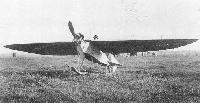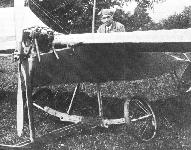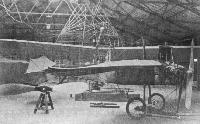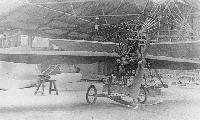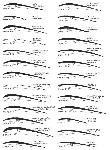
Описание
Страна: Великобритания
Год: 1910
Варианты
- Handley Page - Type A (C) / H.P.1 (H.P.3) - 1910 - Великобритания
- Handley Page - Type D / H.P.4 - 1911 - Великобритания
- C.Barnes Handley Page Aircraft since 1907 (Putnam)
- M.Goodall, A.Tagg British Aircraft before the Great War (Schiffer)
- P.Lewis British Aircraft 1809-1914 (Putnam)
- Журнал Flight
-
Журнал - Flight за 1910 г.
View of the very simple chassis employed on the Handley Page monoplane. The natural flexibility of the ash axle constitutes the suspension.
-
M.Goodall, A.Tagg - British Aircraft before the Great War /Schiffer/
HP Type A (HP1) The 'Bluebird' of 1910 with Weiss-type wing.
-
C.Barnes - Handley Page Aircraft since 1907 /Putnam/
Bluebird after addition of tailplane in May 1910.
-
C.Barnes - Handley Page Aircraft since 1907 /Putnam/
Frederick Handley Page in Bluebird in April 1910.
-
C.Barnes - Handley Page Aircraft since 1907 /Putnam/
Bluebird rebuilt as Type C in 1910 with Alvaston engine, with wings of Type D in background.
Другие самолёты на фотографии: Handley Page Type D / H.P.4 - Великобритания - 1911
-
M.Goodall, A.Tagg - British Aircraft before the Great War /Schiffer/
HP Type C (HP3) was a reconstruction of the Type A with Alvaston engine.
-
M.Goodall, A.Tagg - British Aircraft before the Great War /Schiffer/
HP Type C (HP3) with Isaacson radial engine.
-
Журнал - Flight за 1910 г.
WING SECTIONS. - The above diagrams afford an interesting comparison of the wing sections of aeroplanes exhibited at Olympia. They are all drawn to a common scale, but have been set at an arbitrary angle of incidence, which does not necessarily represent that of the aeroplane In actual flight.
Другие самолёты на фотографии: Avro Triplane I / II - Великобритания - 1909Bleriot Bleriot-XI - Франция - 1909Farman Farman-III - Франция - 1909George & Jobling biplane - Великобритания - 1910Gregoire-Gyp Type 1910 - Франция - 1910Howard Wright Avis - Великобритания - 1910Howard Wright E.N.V. monoplane - Великобритания - 1910Howard Wright Ornis - Великобритания - 1909Humber biplane - Великобритания - 1910Humber Le Blon type monoplane - Великобритания - 1910Humber Lovelace type monoplane - Великобритания - 1910Lane monoplane - Великобритания - 1910Nicholson monoplane - Великобритания - 1910Petre monoplane - Великобритания - 1910Santos-Dumont Demoiselle - Франция - 1907Short Biplane No.2 / No.3 - Великобритания - 1909Sommer Sommer-1 - Франция - 1910Spencer-Stirling monoplane - Великобритания - 1910Star monoplane - Великобритания - 1910Twining biplane - Великобритания - 1910Wright Wright III / Wright A - США - 1905Zodiac No. 3 biplane - Франция - 1911
C.Barnes Handley Page Aircraft since 1907 (Putnam)
Early Single-Seat Monoplanes A, C and D (H.P.1, 3 and 4)
<...> For his first powered machine he may have been unduly bold in choosing a tractor monoplane, but it was cheaper to build than a Wright or Voisin-type biplane, and his primary aim was to fly at minimum cost. Nevertheless, he employed only the best quality spruce, ash, steel plate, piano wire and stranded cable in the construction of his first aeroplane.
The wing, of Weiss’s patent shape, had a stiff inner box with four parallel spars and chordwise ribs, with flexible ribs extending radially from the outer ends of the spars. In view of the automatic stability claimed by Weiss, warping for lateral control was deemed unnecessary, and the inner ends of the spars were pinned to the top longerons and wire-braced above to a central vertical kingpost and below to the chassis. The fuselage was boat-shaped, with four longerons tapering to the stern; the two lower longerons converged halfway back to the tail, so that the rear fuselage section was triangular, and the two upper longerons were reinforced at the forward end to act as bearers for the 20 hp Advance vee-four air-cooled engine; a small petrol tank was strapped across the top longerons in line with the leading edge of the wing. The engine was direct-coupled to a 6 ft 6 in diameter two-blade airscrew copied by Handley Page from a design by Weiss for Lascelles & Co; Handley Page was not prepared to buy what he could make more cheaply himself and had begun selling his own popular range of airscrews, enabling him to undercut Lascelles’ prices. The control surfaces comprised a cruciform tail unit, combining elevator and rudder and mounted on a universal joint, as in Santos-Dumont’s Demoiselle. The wing, fuselage and empennage were covered with blue-grey rubberised fabric, and the chassis had a central channel-section ash skid, with a resilient ash cross-axle carrying a lightweight wheel at each end, having tension spokes radiating from wide hubs designed to resist side loads; the axle was stiff enough to carry the static weight while taxying and taking off, but flexible enough for the skid to take the main landing impact.
This first monoplane, Type A or Bluebird, was still unfinished when exhibited on Stand No. 82 at the second Olympia Aero Exhibition in March 1910, with a price tag of ?375, and although the critics were kind no customers came forward. The general opinion was that the empennage was too small and, indeed, on its first trials the elevator power was insufficient to prevent the skid digging into the ground when the engine was opened up; but this was countered by reinforcing the axle and moving it 4 inches forward, at the same time adding a small triangular fixed tailplane. Thereafter the rudder was effective for ground steering at 15 mph and the elevator at 20-25 mph; but it was not until 26 May, 1910, that Handley Page became airborne, only to sideslip into the ground on his first attempt to turn across wind. This indicated the need for positive lateral control to correct overbanking, so during reconstruction Handley Page incorporated wing warping and enlarged the rudder. The single top kingpost was replaced by a twin-strut pylon; the axle was shortened and further reinforced, and the temperamental Advance was replaced by a 25 hp Alvaston flat-twin water-cooled engine driving a heavy square-tipped airscrew; a rectangular multitube radiator was mounted above the engine edge-on to the slipstream and slightly to the left of the centreline so as not to interfere with the pilot’s view. But the Bluebird, thus modified and now known as Type C, refused to fly in spite of its more powerful engine; so Handley Page next installed a 50 hp Isaacson five-cylinder air-cooled radial, which necessitated further strengthening of the fuselage front-end and chassis, the outer ends of the axle being braced to the upper longerons by struts incorporating rubber-cord shock-absorbers. This was completed late in 1910, by which time Handley Page had begun work on a new monoplane, Type D, so the modified Bluebird was set aside, eventually reappearing in the Northampton Polytechnic Institute’s aeronautical laboratory at Clerkenwell, as an instructional airframe.
<...>
Monoplane A (20 hp Advance)
Span 32 ft 6 in (9-9 m); length 20 ft 6 in (6-25 m); wing area 150 sq ft (13-9 m2). Empty weight 300 lb (136 kg); loaded weight 450 lb (204 kg). Speed 35 mph (56 km/h). Pilot only.
Monoplane C (25 hp Alvaston)
Span 30 ft (9-15 m); length 21 ft (6-4 m); wing area 150 sq ft (13-9 m2). Empty weight 250 lb (113 kg); loaded weight 450 lb (204 kg). Speed 35 mph (56 km/h). Pilot only.
Описание:


